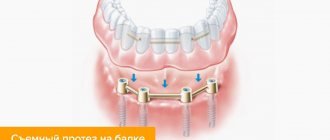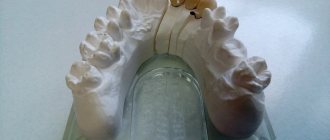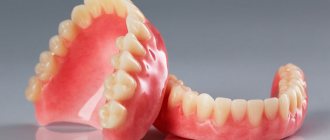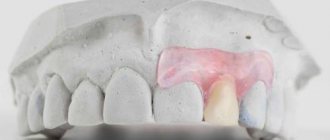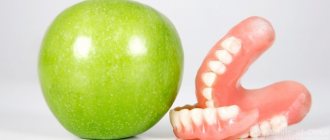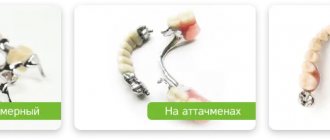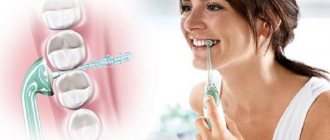Indications for installation
Plastic dentures are necessary to replace all the teeth in the mouth or some of the lost elements.
Indications for installation:
- Complete absence of teeth. In this case, the structure will be attached to the gums due to the vacuum effect. This type of product is called removable suction cup jaws.
- Partial absence of elements. In this case, the devices are attached to the oral cavity using clasps. The structure is supported by its own preserved elements.
- Missing one unit in a row. In this case, dentists advise patients to have a butterfly denture. This system can be used as a temporary replacement for missing teeth until a permanent denture can be made.
Plastic structures are suitable for fixing mobile teeth, masking deformed elements and temporarily replacing missing segments in a row. There are few contraindications for installing plastic structures. The main ones are an allergy to acrylic, a short crown part of the tooth, and various malocclusions.
Difference from nylon models
Many patients are interested in which dentures are better - nylon or acrylic. Indeed, these materials are very common and constantly compete with each other.
They have the following differences:
- Acrylic. It has a solid structure and holds its given shape for a long time. It has a porous composition and is susceptible to the formation of microbes. Releases toxic components during prolonged wear. Can be fixed using special glue. The main advantage of such models is the affordable prices for acrylic dentures.
- Nylon. Soft material that adapts well to the oral cavity. May become deformed over time. Structures made from it are non-porous, so there is almost no plaque or odor on them. The material does not emit toxic substances. As a rule, removable products are fixed due to the suction effect; cream may not be used. Prices for nylon prostheses are quite high.
Types of products
There are several types of systems depending on the production method, the materials used and the method of attachment in the oral cavity.
Structures are made in 2 ways:
- Compression pressing method. Such a product may not be ideally suited to the parameters of the jaw. However, in this case, getting a removable denture is the easiest and fastest way. Disadvantage of the system: long adaptation period, fragility.
- Casting method. With the help of casting, structures that most precisely match the parameters of the jaw are obtained. They imitate the patient’s teeth and gums as accurately as possible.
Based on the method of fastening, plastic products are divided into removable and non-removable. The first type is recommended for complete absence of teeth. Acrylic is usually used to produce a removable jaw.
Partially removable dentures are recommended for patients to temporarily replace elements when installing dentures. Another indication for their installation is partial edentia. Dentists consider plastic structures as a temporary solution to the problem, since the materials used for their production are of low quality and have low performance properties. The procedure allows patients to maintain an attractive appearance until it becomes possible to undergo prosthetics.
Butterfly prosthesis
Dental plastic or acrylic is most often used in the production of dentures. However, other, more modern materials are also used:
- Ethacryl. It has better strength and performance characteristics compared to acrylic.
- Bicryl. It is resistant to mechanical stress. Does not crack or sag when consuming hard foods.
- Ftorax. It is a translucent material that is invisible in the mouth.
- Acree Free. Made from acrylic resins. It is hypoallergenic due to the absence of monomers in its composition.
Removable dentures and their types
Dentures can be partially removable, completely or conditionally removable.
Completely removable structures are most often used for complete tooth loss. They are made from individual casts taking into account all anatomical features. They are made as comfortable as possible and at first it is recommended not to remove them at all, so that the body gets used to it and the doctor can observe its reaction to the prosthesis.
If necessary, adjustments are made to make their use more comfortable. This removable denture looks very natural. It is made from materials such as nylon or plastic. They are non-toxic and safe for health.
Conditionally removable dentures do not need to be removed during sleep. They are recommended if one tooth is missing. The structure is attached to adjacent teeth using special cement, glue or metal hooks.
Partially removable structures are not the most convenient option. They are attached to the gums and take up a lot of space. This option is suitable for both permanent and temporary use and can replace one or more teeth. It's not a perfect technology, but it's still very popular due to its affordability.
Prosthesis manufacturing technology
Before installing the prosthesis, the doctor examines the patient’s oral cavity and identifies any contraindications to the procedure. After this, the person is sent for an x-ray to identify the location of the roots of the remaining teeth. Those elements that cannot be restored using conservative techniques must be removed.
Prosthetics are not performed even if there are tumor-like formations in the soft tissues of the mouth. Procedures are prescribed only after removal of the seal (alveolectomy).
The production of a removable denture from acrylic plastic occurs in several stages:
- Grinding of supporting teeth. The procedure helps prevent negative consequences associated with contact between enamel and plastic. The duration of the work ranges from 40 minutes to 3 hours, depending on the specifics of the procedure.
- The dentist takes an impression of the patient’s teeth and sends it to the laboratory for further fabrication of structures. The height of the bite is determined using wax rollers for 15-20 minutes.
- In the laboratory, a wax model of future dentures with artificial teeth implanted into it is recreated.
- After making the model, the orthopedist tries it on the patient's jaw.
- At the last stage, a plastic denture is made. After installation in the oral cavity, the structure is polished and ground. The color of the enamel is selected by the doctor during the clinical stages of treatment.
The injection molding method and pressing have similarities in preparatory activities. In each case, a preliminary formation of a three-dimensional model of the patient’s oral cavity occurs.
For better fixation of the product in the oral cavity, patients are recommended to use special glue. The substances are used once a day: they are applied in a thin layer to the surface of the material in those places where it comes into contact with the gums. At night, the product is removed, and the remaining adhesive is removed.
The choice of a suitable composition is important for reliable fixation of the structure. The degree of patient comfort when wearing a prosthesis depends on the correct decision. Before giving preference to one or another product, you need to pay attention to the following nuances:
- The glue must retain its effect for at least 12 hours. Otherwise, the application procedure will have to be repeated several times a day.
- The paste should be of medium consistency. Liquid glue will spread over the denture, and solid glue will be noticeable in the oral cavity when you smile.
- Preference is given only to pharmaceutical products. Adhesive obtained from hand can cause swelling and redness of the soft tissues of the mouth.
List of popular denture creams:
- Protefix;
- Lakalut;
- Corega.
Popular adhesive for dentures
Design Features
The structure is made of acrylic plastic. This material looks natural and is well compatible with oral tissues. A qualified specialist is able to select a model that will fully match the shade of the gums and teeth.
Depending on the size of the prosthesis, its base can cover the entire gum or part of it. The artificial dentition is securely attached to the base and exactly replicates natural teeth. This model is very comfortable to wear, does not give a person any unpleasant sensations, and can be removed at night or left in the mouth until the morning.
Photos before and after installation
With careful care, the structure can last from 3 to 5 years. But if you do not pay due attention to cleaning the dental product, drop it on the floor, or often eat hard food, then this will negatively affect its service life.
There are many types of acrylic dentures. Depending on how many teeth need to be replaced and what installation method will be used, there are several types of construction:
- Full. Indicated in the absence of all teeth.
- Conditionally removable. Such models are a temporary option placed on implants. In the future they will be replaced with other prostheses.
- Partial. They replace only part of the lost teeth. Installed on natural support units. Hooks and clasps are used for fixation.
- Butterfly dentures. They are used to replace one or more teeth and are attached to adjacent healthy ones. A very comfortable design that can be left on during the night.
Full
Full
Partial
Butterfly for 2 teeth
Pros and cons of dentures
Among the positive characteristics of plastic dentures, the following should be noted:
- accessibility to wide sections of the population;
- colorlessness, making dentures similar to natural teeth;
- invisibility of the product while smiling;
- speed of production in contrast to metal-ceramics;
- Possibility of installation in 1 visit to the dentist;
- the ability to select a design of any color, shape and size.
Which dentures are best for teeth?
Like other dental structures, plastic dentures have their disadvantages:
- short service life (less than 5 years);
- the likelihood of developing allergic reactions to acrylic;
- the appearance of bad breath due to insufficient care of the structure;
- the possibility of damage to the soft tissues of the mouth due to the large area of contact of the prosthesis with the palate;
- loss of taste of consumed products due to the product blocking taste buds;
- inability to chew hard foods;
- the need for constant visits to the doctor to assess the condition of the prosthesis.
Due to the porous structure, the color of the prosthesis may change, so when wearing it, it is better to avoid coloring products (juices, soda, coffee, tea), so that the material retains its appearance for as long as possible, it is necessary to give preference to high-quality metal-plastic.
The latest development - Vertex
Not long ago, the semi-rigid Vertex design was developed, which has already received many positive reviews. The following features can be highlighted:
- The material is characterized by high density and exceptional smoothness.
- The chewing load is evenly distributed on the upper and lower jaws of the product.
- The design is resistant to temperature changes and retains its shape even when eating very hot food.
- The prosthesis does not change color and does not absorb any odors.
- The product does not emit harmful substances and does not contain monomers.
- The models are very resistant to mechanical damage.
Vertex models look like this:
Acrylic
Partially removable
Partially removable
Telescopic and on implants
You can make the design in any of 12 shades:
Product care
To increase the life of artificial teeth, you need to follow certain rules for caring for them. It is important to clean the structure from food debris and plaque in a timely manner to prevent bad breath and the development of dental diseases. Patients wearing plastic prostheses must:
- Clean the product daily using a brush and paste;
- after eating, remove the device from the mouth and rinse under running water;
- do not remove the structure at night during adaptation;
- do not store artificial teeth without a special solution;
- For care, use special tablets and pastes.
Cleaning the prosthesis
What problems may arise after installing a denture?
Adaptation to a removable denture begins almost immediately after installation is completed in the dentist's office. And, according to statistics, almost every patient experiences certain difficulties that are associated with the adaptation period. Here are some of them:
- Vomiting reflex . Constant vomiting is a completely normal reaction of the body to a foreign object in the oral cavity, so there is no need to worry too much about this. But there is a category of people who take the longest to get used to dentures, or who don’t get used to them at all. The installation of products that stick to the sky is contraindicated for them. This must be taken into account when choosing a prosthetic method. Often, this problem goes away on its own. But for patients with hypersensitivity, it is better to abandon such structures altogether.
- Profuse salivation . The human body perceives the prosthesis as food, as a result of which the brain sends signals that then activate the corresponding functions, namely the secretion of saliva and gastric juice.
- Unpleasant sensations while eating . First of all, this problem affects the owners of removable dentures; the load is unevenly distributed across the jaw, in contrast to the natural chewing of food with real teeth. It takes a long time to get used to this.
- Perception of taste . You may partially lose your sense of taste, since not only the tongue (as many believe), but also the rest of the oral cavity is involved in its perception. The patient may stop feeling spicy, salty, hot or sweet foods; this process occurs differently for everyone.
- Distortion of speech . The prosthesis and its protruding parts can interfere with the tongue; a person with an installed prosthesis has difficulty pronouncing words. But after some time (about a week), diction returns to normal.
Question-answer section
What is the maximum service life of dentures?
Experts say that the average service life of the device is 3 years, but with good care you can increase the service life to 5 years. If there is even the slightest damage to the plastic, you should immediately contact the clinic for restoration work.
Removable teeth are also sent for repair if the functionality of the locks is impaired or the initial shape of the arch changes. The price for repairing the product depends on the complexity of the dental work and the size of the structure.
Why does plastic turn dark?
The problem occurs due to the roughness of the material. The porous structure is maintained even after polishing and grinding the linings. Because of this, food and dye residues accumulate on the surface of the prosthesis. Structures lose their original appearance due to plaque.
How to whiten a denture?
The removable jaw is effectively cleaned using abrasive compounds. To do this, you can use special powders or regular baking soda. The procedure should not be repeated too often, as the abrasive components leave small scratches on the product. Because of this, even more plaque accumulates on their surface.
How to clean dentures?
Pharmacies sell many products designed for cleaning and whitening removable jaws. They are usually sold in tablet form to be dissolved in water. The product is immersed in a disinfectant liquid overnight. The most popular manufacturers of tablets for cleaning dentures: Dental, White, Corega, President. Such cleansing is carried out once every 7 days. The procedure gives the structures their original appearance and prevents the proliferation of pathogenic bacteria on their surface.
How is professional whitening of artificial teeth performed?
If home care methods for the device do not produce results, you should contact the clinic for a professional cleaning procedure. This service is provided by almost all dental institutions. In a clinical setting, the prosthesis is polished to reduce contamination later.
Useful tips for those who have recently installed a prosthesis
Literally from the first days of using a prosthesis, many patients complain of pain, as well as abrasions and scratches in the oral cavity. In fact, mechanical damage should not occur, since this point was thought out at the product design stage. Perhaps you are simply wearing it incorrectly. If the problem does not resolve itself, you need to contact your dentist for further adjustments to the prosthesis.
The tips given below will not completely relieve you of difficulties during the adaptation period, but they will significantly reduce the level of negative impact and will help you get used to the prosthesis faster.
The process of chewing food causes pain, so in the first few weeks it is better to protect yourself from eating solid and tough foods: meat, nuts, cookies, etc. If even soft food is painful to chew, then at first you can cut it into small pieces. Trust your feelings, and when the pain begins to subside, gradually move on to your usual, normal diet.
Under no circumstances should you reduce the number of meals. Most patients, due to a strong fear of getting damage to the oral cavity (and they take a very long time to heal), switch to liquid foods and yoghurts. But this is not the right solution, since in order to get used to the prosthesis, a constant chewing load is needed.
Foods such as pears, apples and citrus fruits should be cut into small pieces and chewed slowly, with great effort. This allows you to reduce the degree of damage to the mucous membrane, and also gives the body all the necessary vitamins.
If you have a dry mouth or increased salivation, it is recommended to drink plenty of liquid in small sips throughout the day.
If you feel slight numbness, you can do a light massage of the gums, this will improve blood circulation and the numbness will go away in just a few minutes. In this case, you need to remove the prosthesis.
Decoctions of herbs such as sage and chamomile will help strengthen your gums and prevent irritation. It is advisable to carry out the procedure three times a day. The decoction should never be hot; liquid at room temperature is the best option.
Patient reviews
Oksana, Tver. The doctor recommended prosthetics with plastic structures to me after I lost 1 tooth, visible when I smile. There was no money for implantation, so I was recommended an alternative way to restore a lost tooth - a butterfly denture. The cost of the design is only 15,000 rubles. The product is invisible when worn. At night, remove the structure and clean it with a brush and special paste. People around me don’t notice that one of my teeth is not real.
Kostya, Samara. Since I was young I have had problems with my teeth and regularly see the dentist. After the teeth began to loosen, the doctor suggested installing a self-adhesive plastic denture. At first it was unusual to talk and eat solid food, so I took all meals only in crushed form. I was able to return to my previous diet after 3 weeks.
Anton, Perm. After a maxillofacial injury, my 3 front teeth were removed. This situation caused my discomfort in front of others. After some hesitation I made a choice in favor of a plastic bridge. The product was manufactured in a short time, but after its installation I felt significant discomfort while talking and eating. Another unpleasant problem was that the prosthesis constantly rubbed the gums. I had to go back to the clinic to have the product corrected. It’s been 2 years now and now I wear the prosthesis regularly, taking it off only at night. I don’t feel the same discomfort from wearing it.
Factors influencing adaptation time
The individual characteristics of a person, his psychotype and desire, influence how quickly he can get used to removable dentures.
Other factors include:
- How well the design fits in the mouth. If the restoration does not adhere well to the palate, it causes constant discomfort. It is difficult to get used to such a prosthesis. It shrinks and damages the mucous membranes.
- Is there any pain? It's hard to feel like your artificial jaw is yours when you're constantly in pain.
- Prosthesis design. It is easier to get used to clasp dentures than to plate dentures. It will take longer to get used to the upper denture.
- Quality of manufacture of dentures. The gag reflex will not go away if the distal (back) edge is too long and irritates the palate. A poorly fitted restoration rubs the gums and causes discomfort when chewing. This design needs correction.
Getting used to removable dentures occurs much faster if the denture is not your first. Usually it takes 3-5 days
.
Complications after dental prosthetics
- Sores and chafing after installation of dentures;
- Inflammatory process on the gums under dentures. Stomatitis;
- Diseases of supporting teeth (caries, pulpitis, periodontitis, etc.);
- Allergy to materials used to create prostheses;
- Galvanic syndrome;
- Loosening the fixation of removable structures;
- Changing the position of the cheeks and lips.
Let's look at each of the complications in more detail.
Sores and chafing after installation of dentures
A common phenomenon, especially typical for removable structures.
Symptoms
- Unpleasant sensations, pain while eating;
- Feeling of a foreign body in the mouth;
- Profuse salivation.
Treatment
The next day after the installation of a removable structure, there is always a follow-up appointment at the dentist's office. Regardless of the presence or absence of unpleasant sensations, it is necessary to come to the clinic for an examination, otherwise, if this is not done, bedsores will form .
If necessary, the doctor will correct the prosthesis and set a date for the next visit. At least two amendments are required for everyone.
During the first two to three weeks, you get used to the dentures, and discomfort is completely normal. Full adaptation usually occurs by the end of the third week.
Prosthetic stomatitis
Prosthetic stomatitis
One of the most common complications.
Symptoms
- In the first time after installing the prosthesis, in addition to discomfort, excessive pressure on the mucous membrane and pain are felt. Redness of the gums appears, and possibly the formation of pustules on the mucous membrane. Small blood vessels are pinched, and the blood supply to the tissues is disrupted at the site of contact - bedsores form;
- The fixing elements of partial dentures can also irritate the surrounding periodontal tissues and contribute to their inflammation.
Treatment
It is necessary to visit your doctor, who will carry out antiseptic treatment of the oral cavity and dentures, prescribe local anti-inflammatory therapy (rinses, mouth baths, ointments, gels), as well as a set of procedures aimed at accelerating tissue regeneration.
Diseases of supporting teeth
In the case of partial dentures, there are teeth in the oral cavity that perform the important function of supporting and securing the denture. Whether the supporting teeth are healthy, covered with crowns or restored with fillings, in any case it is necessary to take care of it and maintain hygiene of the entire oral cavity.
Symptoms
- Visible accumulations of food debris, plaque on teeth, as well as on removable structures;
- Unpleasant odor from the mouth and from the prosthesis;
- Bleeding gums around supporting teeth;
- Painful sensations during meals, from temperature stimuli, night pain.
Treatment and prevention
- Maintain regular and thorough care of dentures and teeth;
- Visit a doctor for professional oral hygiene;
- If pain occurs during chewing, as well as aching, sharp pain, contact your dentist.
Allergy to dentures
Allergy to dentures
An allergic reaction to denture materials can occur when the dentures come into contact with the tissues of the patient's body.
Currently, scientists are trying to minimize the occurrence of such reactions, and today many different materials for the manufacture of removable dentures.
The rate of occurrence of an allergic reaction can vary - from several minutes to several hours, and sometimes days after installation of the prosthesis.
Symptoms
- Rashes on the skin of the face;
- Redness and swelling of the oral mucosa;
- Attacks of bronchial asthma. Suffocation;
- Inflammation of the salivary glands;
- Dry mouth;
- Burning sensation of tongue.
Treatment
- Remove dentures;
- Contact an orthopedic dentist as soon as possible;
- Carry out repeated prosthetics with structures made of a different material.
Galvanic syndrome
This complication after prosthetics is the formation of galvanic current in the oral cavity.
The cause of the occurrence is the presence of dissimilar metals in all structures installed in the oral cavity (for example, used as the base of a prosthesis and as part of crowns) if a particular patient is predisposed to this disease.
In modern dentistry, in the manufacture of dentures, metals and their alloys are used, such as stainless steel, cobalt-chrome, silver-palladium alloys, alloys based on precious metals and others.
It is known that any alloy immersed in an electrolyte solution (in this case, saliva acts as this) acquires a potential unique to it. If metals with different potentials are present in the patient’s oral cavity, then all the conditions necessary for the formation of galvanic current arise.
Symptoms
- Unpleasant sensations while eating;
- Metallic taste in the mouth;
- A bitter and acidic taste in the mouth, especially aggravated when a metal spoon touches the dentures;
- Headache;
- Sleep disorders;
- General malaise;
- Allergic manifestations on the oral mucosa (swelling, erosion);
- Darkening of metal prostheses.
Treatment
- Repeated prosthetics, excluding the presence of dissimilar metals in the oral cavity.
Loosening the fixation of removable structures
Weakening of fixation of removable structures
This complication develops gradually, as the design of lamellar prostheses approaches the end of their service life.
In the case of clasp prosthetics, it is also possible for the plastic parts of the locking prostheses to wear off and the clasps to loosen .
Causes
- Daily use, regular removal from the oral cavity, changes in the anatomical structure of the prosthetic bed (loss of bone tissue with age).
Symptoms
- Sensation of displacement, movement of the prosthesis in the mouth;
- Lack of adherence of the prosthesis to the gums and teeth;
- Loss of structures from the mouth during eating and talking.
Treatment
- Making a new removable denture;
- Using special dental adhesives for fixation.
Correction of fastenings, relining of the prosthesis
Correction of fastenings, relining of the prosthesis
Relining of the prosthesis - correction, restoration of a removable structure in order to obtain a denture base adapted to chewing pressure, clarifying its fit to the prosthetic bed.
Over time, atrophy of the mucous and bone tissue occurs under the base of the removable denture. Atrophy leads to uneven distribution of chewing pressure between the supporting teeth (if any) and the mucous membrane. Failure to reline a removable denture can lead to its breakage and loss of supporting teeth.
Relining can take place either directly in the patient's mouth or in the laboratory.
Method of relining a removable denture in the clinic
- The dentist removes a thin layer of plastic from the surface of the prosthesis adjacent to the mucous membrane of the prosthetic bed and applies an even layer of self-hardening plastic to the treated base. After some time, the prosthesis is inserted into the oral cavity, installed and pressed, after which the patient closes his jaws. Excess plastic is removed with a spatula. After this, the prosthesis is removed and placed in a special apparatus, where the final polymerization of the plastic (hardening) takes place;
- Changing the position of the cheeks and lips.
Causes
- Errors at the stages of prosthesis manufacturing: excessive or insufficient thickness of the base in the frontal region, incorrect determination of the height of the lower third of the face and the centric relation of the jaws, inaccurate placement of artificial teeth in the base of the prosthesis.
Symptoms
- “Failed” or, conversely, excessively protruded lips;
- Biting cheeks with removable dentures;
- Deep nasolabial folds;
- Drooping corners of the mouth;
- The ability to close your lips only with force, while in a relaxed state your teeth are visible;
- Feeling of tightness in the cheeks.
